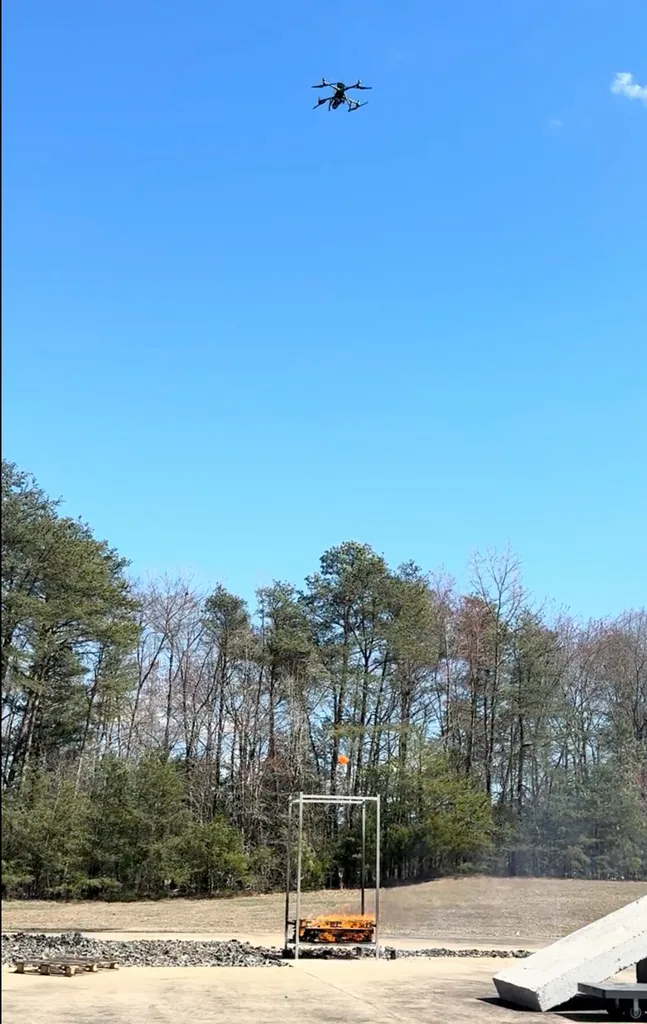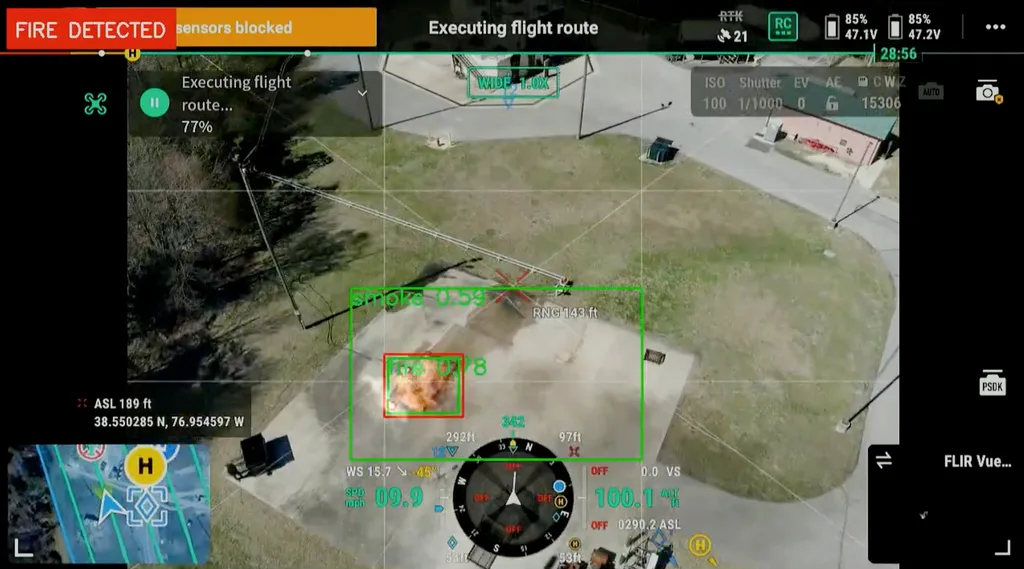- April 29, 2025
- By Annie Krakower
Dark smoke from a stack of pallets set ablaze billowed up against a bright blue sky at the Maryland Fire and Rescue Institute (MFRI) in La Plata, Md., prompting a four-rotor drone to lift off nearby. After surveying the area in a back-and-forth pattern, it centered itself over the fire with a single red water balloon suspended beneath it. The balloon dropped and burst at the precise location to tame the flame—while a Terp team burst into cheers.
The scene last month represented a successful test of a prototype for an airborne robotic firefighter developed by Crossfire, a University of Maryland team of students and faculty competing in XPRIZE Wildfire. Launched in 2023, the four-year, $11 million privately funded competition challenges participants from around the world to design solutions to detect and suppress high-risk wildfires in 10 minutes or fewer, before they can grow deadly.

After more than 100 teams registered, Crossfire—part of xFoundry@UMD, a new hub of innovation and entrepreneurship on campus to solve big problems—was one of 49 to make the cut to advance to this fall’s semifinal stage.
“You really learn well when you have to apply your system in the real world,” said aerospace engineering student and Crossfire team member PJ Collins M.S. ’25. “It’s really inspiring to be able to work on something that’s trying to solve an imminent issue.”
Extreme fires in places like Hawaii, North Carolina and Los Angeles in recent years are part of a devastating trend that has seen wildfire frequency increase 400% since 1970 in the Western U.S. alone. It’s one example of a significant problem that xFoundry@UMD is challenging Terps to tackle; students in its 15-month Xperience competition, meanwhile, are working to enhance safety in K-12 schools, with the winning startup earning up to $2 million in venture capital funding. The top team will be announced in September.
“We’re rapidly heading to a time where just being taught knowledge isn’t enough to succeed in the world anymore. You have to really know how to put your knowledge into practice,” said Phillip Alvarez, xFoundry@UMD associate director. “(XPRIZE Wildfire) is an absolutely fantastic opportunity for students to work on a project that has near-term economic value, that speaks to a societal grand challenge that exists right now.”
Students are playing key roles in both the detection and suppression sides of Crossfire’s solution, with Collins leading the development of the detection system. Thermal and optical cameras work together to search an area for a fire, with data streams from both fusing to help spot any flames. Artificial intelligence also assists with detection, and a GPS-linked laser rangefinder embedded in the optical camera pinpoints the blaze’s location.

Then, the drone would fly to that location with an attached suppression system—like a fancier version of the water balloon contraption on their current prototype—that fire protection engineering student Lindon Luu M.S. ’25 is working to create. Through tests in La Plata, as well as College Park’s MFRI location and UMD’s UAS Research and Operations Center in California, Md., he’s researching how much water is needed to extinguish the pallet fires and how high the balloon-like air burst water reservoir should be when it pops.
“You can think of it as a grenade, where you release the pin, then it has a delay, and then it bursts the balloon over the fire,” Luu said of Crossfire’s prototype. “We have the best of both worlds, where we have accuracy, where we can actually aim the balloon wherever the center of the fire is, and it has enough momentum and an area of coverage to spread across the entire fire.”
He's working with a team of undergrads to develop a release mechanism, like a trap door or a net, for the water reservoir, and they’re integrating larger drones into the system to hold more water and more effectively suppress the fire.
After qualifying for the semifinals with a successful written proposal, the team is gearing up to demonstrate its autonomous system in a closed outdoor test environment in October, with finals scheduled for 2026. The ultimate goal is for Crossfire to continue as an independent company beyond the competition, deploying its solutions across the U.S.
“The XPRIZE challenge has helped me become better as an engineer and as a person in general,” Luu said. “I want to see our project go as far as it can.”
All through April, Maryland Today will celebrate how the University of Maryland is reimagining learning and teaching. Find more stories at today.umd.edu/topic/we-reimagine-learning.
